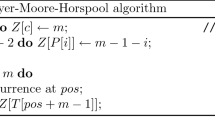Abstract
The design of a high-speed cellular pattern matcher, called theAssociative Linear Text Processor (ALTEP), is presented.ALTEP was originally designed for systems which use signature files as an access method. However, it is also suitable for systems which store the database in fixed length blocks.ALTEP is a linear array of logic cells which respond to commands sent from a central controller over a bus. A text block is loaded into the cells and pattern characters are broadcast to the cells for comparison.ALTEP has the capability of recognizing full regular expressions and is the only cellular logic array which has this capability. It requiresO(p) steps for patterns which do not contain closures andO(len(max(T(P)))) steps for closures, wherep is the the length of the pattern andlen(max(T(P))) is the length of the longest substring in the text which matched the closure.
Similar content being viewed by others
Explore related subjects
Discover the latest articles, news and stories from top researchers in related subjects.References
Bartolini, R. A., “Optical recording: High-density information storage and retrieval,”Proc. IEEE, 70, 6, pp. 589–597, 1982.
Burkowski, F. J., “A hardware hashing scheme in the design of a multiterm string comparator,”IEEE Trans. Comput., C-31, 9, pp. 825–834, 1982.
Christodoulakis, S. and Faloutsos, C., “Design considerations for a message file server,”IEEE Trans. Soft. Eng., SE-10, 2, pp. 201–210, 1984.
Croft, W. B., “Applications for information retrieval techniques in the office,”6th Annual Int. ACM SIGIR Conf. Research and Development in Information Retrieval, Bethesda, Maryland, pp. 18–23, June, 1983.
Ermath, P. A., “Page indexing for textual information retrieval systems,”Report No. UIUCDCS-R-83-1141, Department of Computer Science, University of Illinois at Urbana-Champaign, Oct., 1983.
Finnila, C. A. and Love, H. H., “The associative linear array processor,”IEEE Trans. Comput., C-26, 2, pp. 112–125, 1977.
Foster, M. J. and Kung, H. T., “The design of special-purpose VLSI chips,”IEEE Comput., 13, 1, pp. 26–40, 1980.
Gonzalez-Rubio, R., Rohmer, J., and Terral, D., “The Schuss filter: A processor for non-numeric data processing,”Proc. 11th Annual Int. Sympo. Comput. Arch., Ann Arbor, Michigan, pp. 64–73, June, 1984.
Haskin, R. L. and Hollaar, L. A., “Operational characteristics of hardware-based pattern matcher,”ACM Trans. Database Syst. 8, 1, pp. 15–40, 1983.
Hopcroft, J. E. and Ullman, J. D.,Introduction to Automata Theory, Languages, and Computation, Addison-Wesley Publishing Company, Inc., Reading, Massachusetts, 1979.
Kibler, T. R., “APCAM (A practical cellular associative memory),”Proc. 5th Workshop Comput. Arch. Non-Numeric Processing, Monterey, Calif., pp. 82–83, March, 1980.
Lee, D. L., “A distributed multiple-response resolver for value-ordered retrieval,”Proc. 12th Int. Sympo. Comput. Arch., Boston, Mass., pp. 258–265, June, 1985.
Lee, D. L., “A word-parallel, bit-serial signature processor for superimposed coding,”Proc. 2nd Int. Conf. Data Engineering, Los Angeles, Calif., pp. 352–359, Feb., 1986.
Lee, D. L. and Lochovsky, F. H., “Text retrieval machines,” inOffice Automation (D. C. Tsichritzis, ed.), Springer-Verlag, New York, N. Y., 1985.
Love, H. H., “A modified ALAP cell for parallel text searching,”Proc. Int. Conf. Parallel Processing, pp. 23–16, Aug. 1977.
Mukhopadhyay, A., “Hardware algorithms for nonnumeric computation,”IEEE Trans. Comput. C-28, 6, pp. 384–394, June, 1979.
Roberts, C. S., “Partial-match retrieval via method of superimposed codes,”Proc. IEEE, 67, 12, pp. 1624–1642, 1979.
Roberts, D. C., “A specialized computer architecture for text retrieval,”Proc. 4th Workshop Comput. Arch. Non-Numeric Processing, Syracuse, New York, pp. 51–59, Aug., 1978.
Sacco, G. M., “OTTER—An information retrieval system for office automation,”Proc. 2nd ACM SIGOA Conf. Office Information Syst., Toronto, Ontario, pp. 104–112, June, 1984.
Stevenson, J. W. and Tanenbaum, A. S., “Efficient encoding of machine instructions,”Comput. Arch. News, 7, 8, pp. 10–17, 1979.
Tharp, A. L. and Tai, K., “The practicality of text signatures for accelerating string searching,”Software Practice and Experience, 12, 1, pp. 35–44, 1982.
Tsichritzis, D. C. and Christodoulakis, S., “Message files,”ACM Trans. Office Information Syst., 1, 1, pp. 88–98, 1983.
Author information
Authors and Affiliations
Additional information
Research was done while the author was with the Computer Systems Research Institute, University of Toronto.
About this article
Cite this article
Lee, D.L. ALTEP — A cellular processor for high-speed pattern matching. New Gener Comput 4, 225–244 (1986). https://doi.org/10.1007/BF03037405
Received:
Revised:
Issue Date:
DOI: https://doi.org/10.1007/BF03037405




